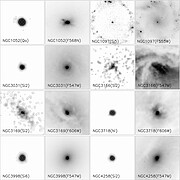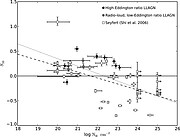Petite AGNs Reveal New Secrets
6 July 2012
High-resolution, mid-infrared observations at Gemini North and South have revealed a wide range of morphologies for low-luminosity active galactic nuclei (AGN). While the data present a broad characterization of these objects' properties in this spectral region, they also present an interesting puzzle to ponder.
Active galactic nuclei (AGN), the supermassive black holes that feed on gas, dust, and stars at the centers of galaxies, spend most of their existence in a near dormant state. Until recently, astronomers had observed only a handful of low-luminosity AGN in the infrared at high resolution. Therefore, we didn't have a good, general overview of their properties in this potentially revealing spectral region. Our observations of 22 low-luminosity AGN, taken with both of Gemini's mid-infrared instruments (Michelle and T-ReCS), have changed this situation.
The images reveal a wide range of morphologies, from galaxies dominated by a central, compact source (much like images of higher-luminosity Seyferts and quasars) to those with weak nuclei embedded in large amounts of extended, mid-infrared emitting material that could signal star formation around the nucleus (geminiann12008a). To complement these observations, we combed the literature for other high-resolution measurements that reveal the emission of the nucleus from radio to X-ray frequencies. We also took advantage of low-resolution but exquisitely sensitive spectroscopy from the Spitzer Space Telescope archive.
A rather complex picture emerged from the data. In some of the most weakly-accreting AGN, even Gemini's resolution doesn’t separate the infrared emission of the nucleus from that of the surrounding galaxy. However, we do find some cases where the infrared emission comes not from dust or the outer regions of the accretion disk, but from synchrotron radiation –– fast-moving electrons spiraling round magnetic field lines in the galaxy’s core. In a couple of those galaxies, the evidence suggests that the dusty torus is indeed absent (see sidebar). This is predicted by some models describing the nature and origin of the torus.
The more strongly-accreting AGN (but still weaker than most of those studied to date), look in many ways a lot like "conventional" Seyfert galaxies in the infrared. It's possible, then, that these low-luminosity AGN aren't as different as we had thought. However, the data do present some tantalizing hints that in these AGN, too, the dusty torus no longer exists. When we compare the dust emission features in their Spitzer spectra with the amount of gas around the nucleus (determined from published X-ray observations), it appears that there is an unusually small amount of dust compared to gas (geminiann12008b). This, again, is expected from some models that attempt to explain the origin of the torus.
If the torus doesn't exist in these objects, then we will need to find another way of explaining their Seyfert-like infrared emission. To better understand the observations, we have started to compare detailed models of the accretion disk, dust and synchrotron emission to the data. But right now we are simply happy to have high-quality observations to puzzle over in the months to come.
AGN: A Closer Look
When astronomers think about active galactic nuclei (AGN), the first thing that springs to mind is often one of the more dramatic examples: a luminous quasar or bright Seyfert galaxy, for instance. In reality, though, an active galaxy will spend only a tiny fraction of its existence in such a spectacular state. Most of the time the central engine will be more like the near-dormant black hole in the center of our own Galaxy, starved of the gas that feeds it and shining only weakly. These "low-luminosity AGN" differ from their luminous cousins in other ways, too.
Theory predicts that the accretion disk of material circling the black hole is extremely hot, puffed-up, and unable to radiate its energy efficiently. Also, whereas quasars and luminous Seyfert galaxies are surrounded by dusty clouds that can hide the accretion disk (collectively known as the "torus"), several models suggest that low-luminosity AGN should have bare, almost dust-free centers. Given how common, and yet how odd, these low-luminosity AGN appear to be, we need to test our hypotheses about them if we want to really understand how active galaxies ingest material and evolve over the course of their lives.
Dust near an AGN heats up and emits copious amounts of infrared radiation. The outer regions of the accretion disk in a low-luminosity AGN might well do the same. Therefore, the natural place to look for signatures of the torus and accreting material is the infrared region of the spectrum. Although ground-based telescopes aren’t as sensitive to infrared light as space-borne observatories like Spitzer –– the Earth's atmosphere itself shines brightly at infrared wavelengths –– telescopes like Gemini have a big advantage: spatial resolution.
Low-luminosity AGN are, by definition, faint compared to the stars that surround the galaxy’s black hole. This means that astronomers need the high resolution of a big ground-based telescope (about a factor of 10 better than Spitzer at a wavelength of 10 microns), due to its ability to separate the central engine from the host galaxy. Only then will astronomers get an uncontaminated view of the nuclei of these commonplace yet poorly-understood objects.
Links
- The article about this research has been published by the Astronomical Journal.



